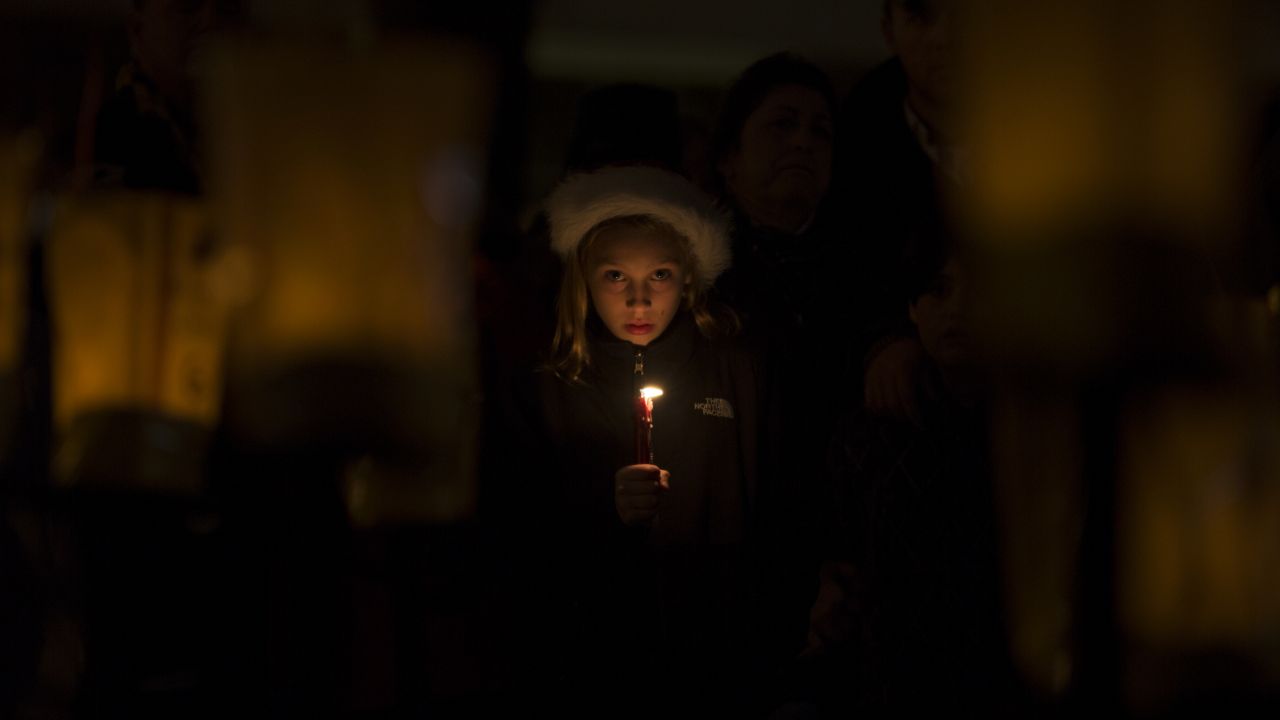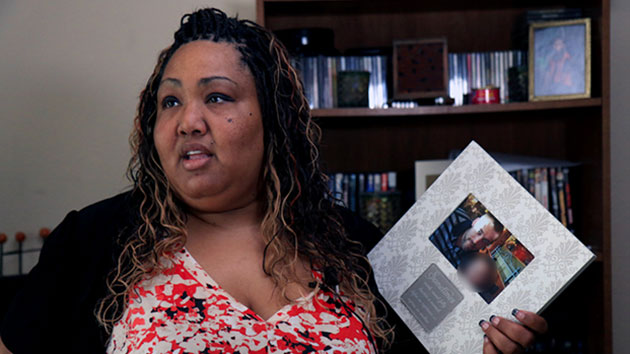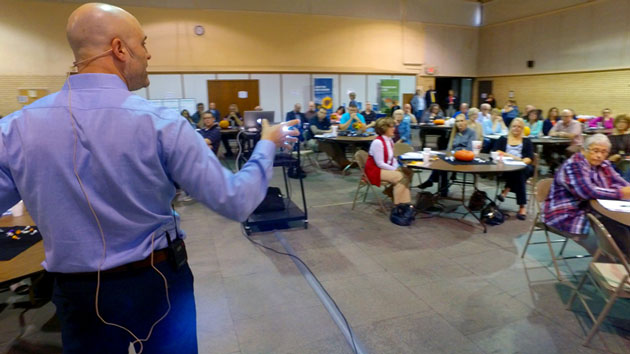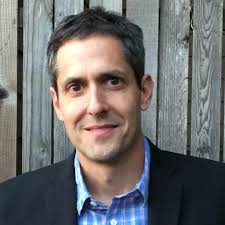
A young girl holds a candle at a townwide community vigil on Sherman Green in Fairfield, Connecticut after the mass shootings at Sandy Hook Elementary School, Newtown, Connecticut, USA. December 17 21012. (Photo by Lisa Wiltse/Corbis via Getty Images)
This post originally appeared at Mother Jones.
On a breezy, unusually warm morning in late October, about 60 cops, mental health counselors, pastors and business leaders are gathered inside a community center in Newton, Kansas, for an intensive training. They sit mostly stone-faced around folding tables with coffee and pastries as Dr. Russell Palarea launches into a close analysis of the 1999 cult comedy Office Space. He explains why the behavior of Milton Waddams — a memorably pathetic cubicle dweller who suffers multiple indignities at the hands of his co-workers — holds the key to preventing a mass shooting.
Palarea cues a series of clips that show Milton muttering under his breath about a prized red Swingline stapler taken from him by his bullying boss. As the film progresses, Milton’s socially awkward affect begins to turn more hostile. Eventually, he slinks into the boss’ office to repossess the stapler. Palarea pauses the video to underscore the telling escalation: “He’s taken matters into his own hands. He’s moved from idea to action.” By the final clip, Milton has burned down the office building and decamped to a beach resort in Mexico, where he mumbles about slipping strychnine into the guacamole. The dark comedy cracks a couple of smiles, serving both as an icebreaker and an initial lesson on the behavioral warning signs of an attack — an obsessive grievance, oblique threats about killing.
Palarea, a forensic psychologist based in Washington, DC, is a leading practitioner of threat assessment, an emerging field in which mental health and law enforcement experts work together to identify and deter individuals who may be poised to commit violent attacks. At his invitation, I’d come to this rural, heavily Mennonite region about 30 miles north of Wichita to observe him train an unprecedented group: Virtually every person in the room was connected to the events of Feb. 25, 2016, when a disturbed employee at the lawnmower plant in nearby Hesston went on a rampage, killing three people and wounding 14 others.
In today’s era of active-shooter drills, leaders here in Harvey County didn’t want to focus just on how to respond in the event of another attack; they wanted to understand what led to the rampage and do what they could to ensure that another one, however unlikely, wouldn’t occur. They had learned about Palarea’s work after reading a 2015 story I wrote about an innovative strategy to prevent mass shootings and flew him in to teach them the fundamentals of threat assessment. Palarea has been in the threat assessment field for more than two decades, consulting with teams for the military, federal agencies, colleges and corporations. When working in these various settings, he told me, he’s always emphasized the same theme: “You need to worry about this happening here.” But the theme in Harvey County was new: “Let’s heal from this and make sure it doesn’t happen again.”
— Dr. Mary Carman
I’d also come to Kansas to gain a deeper sense of the impact from the mass shooting, long after the news cameras were gone and the rest of America had moved on. Though the experience was still raw for many at the training, participants also expressed a sense of empowerment, in part because threat assessment defies the conventional wisdom that nothing can really be done to prevent mass shootings. “As a clinician, when you are confronted with the fact that there might be harm or danger, it’s isolating,” Karla Roth, a mental health counselor, told me. “To know that you can work together and not be alone in it—that’s hopeful.”
Roth was among a small team from Prairie View Hospital in Newton that had rushed to Hesston to help in the immediate aftermath of the shooting. Initially, she didn’t know the status of her husband and son-in-law, who both worked inside the Excel facility. “It was horror. Then when I found out that they were OK, I just had to help,” she said. “This is a peaceful, quiet, want-to-live-in place. To have it happen here is something no one would have ever thought.”
As the sun began to sink across the hayfields, Harvey County Sheriff Townsend “T.” Walton took me for a ride in his cruiser. He retraced a chaotic path that started around 5 p.m. that day. A burst of calls had come over the radio in the span of just a few minutes — one, two, and then three shootings. Gun violence had been relatively rare in Walton’s three decades of law enforcement in the region — and never anything like what he was hearing now. “I’m my head I’m going, ‘Is this terrorism?'” he recalled. It was just two months after the massacre in San Bernardino, California. “I’m not thinking, ‘This is a guy who just got served a protection-from-abuse letter and he’s flipped out.'”
Thirty-eight-year-old Cedric Ford was a recent transplant to Newton who worked the paint line at Excel. He had a criminal record in Florida and had come to the attention of local authorities for beating up his girlfriend. About three hours before the attack, “everything was totally normal” and Ford seemed “happy as all could be,” remarked a co-worker who’d chatted with him in the Excel parking lot. Soon afterward, sheriff’s deputies showed up at Excel to serve Ford with a protection order obtained by his girlfriend, apparently triggering his plan to go on a killing spree. Ford drove home, binged on meth and booze and got back into his car with an AK-47 assault rifle and Glock handgun.
Walton slowed down just past the intersection of 12th Street and Meridian, where he’d reached Ford’s first victims. Paramedics were rushing a middle-aged man with a blood-soaked shoulder out of a pickup truck strafed with bullet holes. The man’s two grandchildren cowering in the rear of the cab were, amazingly, unharmed. Just up the road, Ford had slammed his car to a halt in the road in front of his next victim, a 74-year-old woman who refused his demand to relinquish her vehicle. Miraculously, she also survived unscathed, ducking into the passenger seat as Ford fired through the driver’s side window. Ford succeeded in taking a truck from his third victim; the young man he shot in the leg along Old Highway 81 likely would have died if a sheriff’s deputy hadn’t arrived moments later with a tourniquet. (It is unclear why Ford went on the carjacking spree. His mental state was impaired and volatile, but he also may have been having trouble with his car.)
Walton was handling triage near 12th and Meridian when the radio erupted again: There was an active shooter inside Excel. Emergency dispatchers were quickly overwhelmed with nearly 50 calls from the plant. Walton immediately contacted his chief deputy: “Get ahold of everybody we have and send them to Hesston.”
As police vehicles and ambulances screamed toward the town, Hesston police chief Doug Schroeder had already reached Excel and found pandemonium. The large glass doors at the front of the plant had been shot out. Scores of employees were fleeing across the parking lots, some helping wounded coworkers. Schroeder didn’t know who was shooting inside the mammoth facility, or where. But like most law enforcement leaders trained in the post-Columbine era, he knew he could not hesitate: An active shooter fires an average of every four seconds. And hundreds of people were still inside the building.
Schroeder entered through a side door, his Colt AR-15 rifle in hand. He saw blood trails on the floor both to the left and the right. It was quiet. He went right, toward the main entrance, and began to hear gunfire. He moved through several more hallways to an office area, where he encountered a frightened employee. As they began to speak, the glass window in the door next to them shattered. Ford was just on the other side. “I’m going to get you,” Schroeder recalled him saying.
The terrified employee bolted as the barrel of Ford’s rifle poked through the doorway. Ford came through the door and chased after the employee, unaware that Schroeder was just behind him. Schroeder took aim with his rifle and fired four shots. As Ford spun and went down, he raised his pistol and fired at Schroeder. He missed. “I saw the shell casings being ejected from the handgun, but I didn’t hear the shots,” Schroeder recalled.
Many employees were hiding in nearby offices and Ford was carrying plenty more ammo when he was killed. There is no way to know how many lives were saved by the 41-year-old police chief, who waved off a flurry of praise and said he didn’t want his service to be defined by this one tragic event.
“He’s a humble man,” Walton remarked as we pulled out of the Excel parking lot. “But he was a hero to me, and without a doubt to the hundreds that got to go home that night.”
Excel employs about a thousand people, and many in this sparsely populated region are connected to someone who works at the plant. I visited Subrina Luke, a big-hearted woman with a wide smile, at her small apartment near the Wichita airport. She recalled how she was feeling grumpy when her fiancée Josh Higbee dropped her off at her job that morning: She was short on sleep and had forgotten her usual morning beverage, and she’d closed the car door without even saying goodbye. She was surprised when Higbee walked into the LensCrafters where she worked about 15 minutes later.
“What are you doing here?”
“Just bringing you a drink.”
“You didn’t have to do that,” she said, cracking a grin.
“Yes I did, woman. You would have been calling me for one.”
— Subrina Luke
He kissed her goodbye. They’d been together for almost two years, sharing an apartment and raising Higbee’s spry 4-year-old son from a prior relationship, who called Luke his mommy. A few hours later, the 31-year-old Higbee headed up the road to Excel. He mostly disliked his job as a welder on the second shift but was glad to be pulling in $23-plus an hour for his family.
The first call came from their 4-year-old’s babysitter, whose boyfriend also worked at Excel. “There was a shooting at the job,” she said. Luke’s heart dropped, but the babysitter knew no details and Luke wouldn’t be able to reach Higbee during his shift. She tried to focus on helping her customers. Her phone kept buzzing. During a break, she answered a call from one of Higbee’s co-workers. “I’m sorry,” the woman told her, “but Josh is gone.”

Subrina Luke at home in Wichita. (James West/Mother Jones)
“I think I screamed so loud everyone in the mall heard me,” Luke recalled, fighting through tears as we sat in her living room, sunlight jagging through the window blinds. Higbee’s son, now 5, was playing in the bedroom with a pastor who’d been helping Luke and the boy through the recovery process. The youngster seemed to be doing remarkably well, bounding over to me to show off a favorite toy and hugging Luke affectionately before going off to play while we talked.
Luke reflected on being robbed of her partner, and the boy of his father. “He’s not going to get to see him graduate high school, he’s not going to even get to see him on his first day of school,” she said. “That’s what hurts the most, is what his dad is going to miss and what he’s going to miss.” She recalled when the boy grasped that Higbee wasn’t coming home again. “When you have a 5-year-old break down and cry that he misses his dad, that is the most heartbreaking thing you can ever experience,” she said. “I picked him up and I said, ‘I miss him too, and I’m here for you when you need me.'”
Luke struggled to recount her experience but said she was compelled to share it. People needed to know about who gets left behind and what they face, she said.
“They should have psychological evaluations on everyone that owns a gun,” she continued. “I know that sounds crazy, but they have a way of telling people who are sane and not sane by things that they say. Not everyone should have a gun.”
Why did the shooter do it? And could he have been stopped?
Those twin questions haunt the survivors of every mass shooting, and they are always difficult to answer. Several hours into the threat assessment training, Palarea asked the community leaders whether they were comfortable discussing their own recent case. He’d confided to me over dinner the night before that he wasn’t sure he should even go there, given how fresh the attack still was. And there likely wouldn’t be any satisfying answers to those core questions. Nonetheless, the group agreed to proceed. The discussion was brief and somewhat circumspect (and not for public disclosure), but it underscored behaviors and circumstances to watch out for — domestic violence, drug abuse, menacing comments — and how to communicate more effectively among local agencies and institutions about individuals of concern.
With the encouragement of event organizers, Palarea also decided that he would not leave out his most graphic training material. Ford’s attack was the latest in a long history of similar workplace violence. Palarea gave an in-depth analysis of a 1988 case in Sunnyvale, California, where Richard Farley went on a rampage at the technology company ESL Incorporated, killing seven coworkers and wounding four others. One of the survivors, Laura Black, had rejected Farley’s romantic advances; after he continued harassing her and turned abusive, ESL fired him. This was another case where a restraining order appeared to have triggered the plan for an attack: The day before the order obtained by Black was to go into effect, Farley struck.
— Dr. Mary Carman
Palarea highlighted how ESL’s termination of Farley had obviously turned out to be an inadequate solution to the threat — and may have worsened it. He showed a clip of an interview conducted with Farley after he was taken into custody. Once ESL had fired him, Farley stated coldly to investigators, “They lost control of me.” Punitive measures may well be necessary in response to aberrant behavior, Palarea explained, but understanding and dealing with the root grievance remains crucial.
A few months before the rampage at Excel, Ford had posted a video on Facebook: The footage showed him standing at the side of a road, firing dozens of rounds from an AK-47 into an empty field. Was it just a guy harmlessly blowing off some steam, or something more ominous?
Perhaps a threat assessment team could have gained insight into Ford’s mental state and motivations. “It’s a matter of the community keeping eyes and ears open for concerns,” Palarea explains, “and reporting those concerns to authorities, whether school administrators, workplace threat assessment teams, or the police.” Once a tip comes in, a local threat assessment team scrutinizes the subject’s behavior and circumstances for signs that person could be contemplating an attack. Indicators can include the acquisition of weapons, surveillance of a target, or communicating threats about intended victims, whether directly or indirectly (as is more commonly the case). “Once we get a heads up, we can intervene,” says Palarea. “We can get the person mental health treatment if it’s appropriate. We can help the person resolve conflict in a positive way instead of using violence as a solution to the problem. We can get the people the help they need, to prevent these things from happening.”

Dr. Russell Palarea trains Harvey County’s leaders. (James West/Mother Jones)
Misty Elder-Serene, a director at Prairie View Hospital who arranged the training, told me that the community’s interest in threat assessment stemmed in part from its social ethics: Though rural Kansas is gun country, the heavily Mennonite region is also marked by a culture of pacifism and commitment to social justice, she said. Those crosscurrents prompted some interesting conversations after the mass shooting — not so much a debate about gun violence as a discussion about “how can we heal, and how can we be safe.” The concept of threat assessment resonated with its imperative to better understand and manage people who could turn dangerous.
“It’s easy to just divide it into, ‘Oh well, it’s a gun problem’ or ‘It’s a mental health problem,'” remarked Dr. Mary Carman, a VP of psychological services at Prairie View. “It’s not. It is 12 problems, at least, that have to be addressed.”
Some in the community expressed a striking degree of compassion for the killer. At a church in Hesston on the Sunday evening after the attack, the service included four candles: three for those murdered, and a fourth for Ford. One person who was wounded, speaking to a reporter from his hospital bed, talked about seeing the look in Ford’s eyes and understanding how much pain he was in.
Several leaders at the training expressed the hope that their response to the tragedy might serve as a model for other communities upended by mass shootings. Carman, who has worked in mental health for more than three decades, noted that Prairie View Hospital was founded by World War II-era conscientious objectors who’d served in so-called insane asylums, where people with mental health issues were often treated brutally. The hospital’s founders felt there had to be a more humane and effective way to deal with disruptive, troubled people.
“I think that passion still permeates the [local] culture,” Carman told me. Ford’s attack was shocking, “but we can do something. We can learn more about it. We can help teach others. Some of this can be prevented. Let’s not just sit here and do nothing.”




